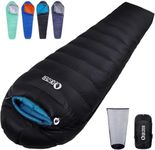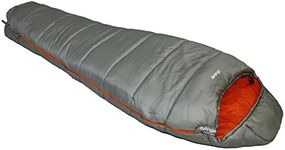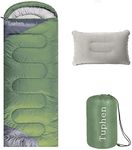Buying Guide for the Best Backpacking Sleeping Bags
Choosing the right backpacking sleeping bag is crucial for ensuring a comfortable and restful night's sleep while you're out in the wilderness. The right sleeping bag will keep you warm, dry, and comfortable, allowing you to recharge for the next day's adventures. When selecting a sleeping bag, consider factors such as the climate you'll be camping in, the weight and size of the bag, and your personal comfort preferences. It's important to balance warmth, weight, and packability to find the best fit for your backpacking needs.Temperature RatingThe temperature rating of a sleeping bag indicates the lowest temperature at which the bag will keep you warm. This is crucial because it helps you choose a bag that matches the climate conditions you'll be facing. Temperature ratings are usually divided into three categories: summer (above 35°F/2°C), three-season (20°F to 35°F/-7°C to 2°C), and winter (below 20°F/-7°C). If you're camping in colder conditions, opt for a bag with a lower temperature rating. Conversely, for warmer climates, a higher temperature rating will suffice. Consider your destination and season to guide your choice.
Insulation TypeInsulation in sleeping bags can be either down or synthetic. Down insulation is lightweight, compressible, and offers excellent warmth-to-weight ratio, making it ideal for backpacking. However, it loses its insulating properties when wet. Synthetic insulation is bulkier but retains warmth even when damp and is generally more affordable. If you're backpacking in wet conditions, synthetic might be a better choice. For dry, cold environments, down insulation is preferred for its superior warmth and packability.
WeightWeight is a critical factor for backpacking sleeping bags since you'll be carrying it along with other gear. Sleeping bags can range from ultralight (under 2 pounds) to heavier options (over 4 pounds). Ultralight bags are great for long treks where every ounce counts, but they may compromise on warmth or durability. Heavier bags might offer more comfort and warmth but can be cumbersome. Consider the length and difficulty of your hike to determine how much weight you can comfortably carry.
PackabilityPackability refers to how compactly a sleeping bag can be compressed into your backpack. This is important for maximizing space in your pack. Down sleeping bags generally offer better packability due to their compressibility, while synthetic bags may take up more space. If you're limited on pack space, prioritize a bag that compresses well. Evaluate your backpack size and other gear to ensure your sleeping bag fits comfortably without taking up too much room.
ShapeSleeping bags come in various shapes, including mummy, rectangular, and semi-rectangular. Mummy bags are tapered and snug, offering better heat retention and are lighter, making them ideal for cold weather backpacking. Rectangular bags provide more room to move and are better for warmer conditions or those who prefer more space. Semi-rectangular bags offer a balance between warmth and space. Consider your sleeping style and comfort preferences when choosing the shape.
SizeSize refers to the length and width of the sleeping bag. It's important to choose a size that fits your body comfortably without being too tight or too loose. Sleeping bags typically come in regular and long sizes, with some brands offering extra-wide options. A bag that's too small can be restrictive and uncomfortable, while one that's too large may not retain heat effectively. Consider your height and body shape to select a size that provides comfort and warmth.

















